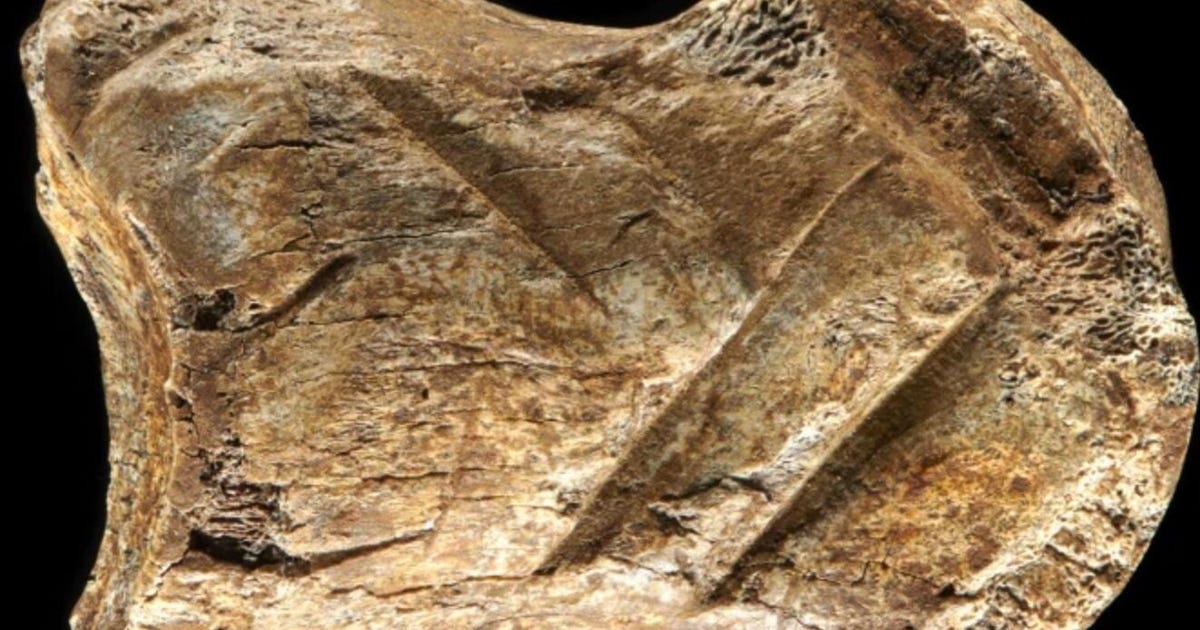
Evidence continues to mount that our Neanderthal brethren may have been more sophisticated than we give them credit for. Artsy even. And researchers point to a 51,000-year-old deer bone as proof.
Researchers say this deer bone displays Neanderthal design skills.
V. Minkus/Lower Saxony Office for HeritageThe researchers uncovered the small toe bone during an excavation at the so-called Unicorn Cave (Einhornhöhle) in northern Germany's Harz Mountains. Among a series of well-preserved Neanderthal artifacts found at the cave's entrance, a bone with a pattern of systematically carved lines stood out.
"We quickly realized these were not marks made from butchering the animal but were clearly decorative," excavation leader Dirk Leder of the Lower Saxony State Office for Heritage said in a statement. Leder and a team of other German researchers detail their discovery in a study published Monday in the journal Nature Ecology & Evolution.
The phalanx displays a geometric pattern consisting of two interlaced sets of lines the scientists believe were achieved through vertical cutting followed by scraping.
Researchers arrived at the bone's age using radiocarbon dating. They say the bone represents the first successful dating of an object that must have been carved by Neanderthals, who lived between 430,000 and 40,000 years ago and are the closest genetic relative to modern humans.
Neanderthals are known to have carved tools and weapons and made adhesives from birch tar, but the marks in the deer bone suggest another level of awareness and imagination.
"While there is substantial evidence for art and symbolic behavior in early Homo sapiens across Africa and Eurasia, similar evidence connected to Neanderthals is sparse and often contested in scientific debates," the study says. "Each new discovery is thus crucial for our understanding of Neanderthals' cognitive capacity."
The bone comes from a giant deer, also known as an Irish elk (though it's neither Irish nor an elk). The extinct species of deer stood an astounding 6 feet, 11 inches at the shoulders and had the largest antlers of any known deer.
Comparing the deer bone to cattle bones, the scientists concluded the archaic human or humans who carved it likely boiled it to soften it into a more pliable material and provide enough firm grip.
"It is probably no coincidence that the Neanderthal chose the bone of an impressive animal with huge antlers for his or her carving," said Antje Schwalb, director of the Institute of Geosystems and Bioindication at the Technical University of Braunschweig and a member of the research team.
Other recent research also contradicts stereotypes of Neanderthals as little more than primitive cavemen. While the exact chronological gap between when Neanderthals declined and Homo sapiens first arrived has yet to be determined, one study suggests the two species likely traded cultural ideas -- sharing memes, in essence -- longer than scientists had previously hypothesized.
Another study found that Neanderthals were into fiber technology. And another concludes that a deaf Neanderthal man with an injured leg and a missing arm likely lived into his forties thanks to the care of his community.
The Unicorn Cave is so named because a 16th century scientist who wrote about the site mentioned local trading with unicorn artifacts. At the time, fossilized Ice Age bones were thought to have come from the mythical creatures and to possess medicinal properties.
The Neanderthal who turned a deer bone into art could not be reached for comment.
https://news.google.com/__i/rss/rd/articles/CBMiWGh0dHBzOi8vd3d3LmNuZXQuY29tL25ld3Mvd2hhdC1hLTUxMDAwLXllYXItb2xkLWNhcnZlZC1ib25lLXRlbGxzLXVzLWFib3V0LW5lYW5kZXJ0aGFscy_SAWNodHRwczovL3d3dy5jbmV0LmNvbS9nb29nbGUtYW1wL25ld3Mvd2hhdC1hLTUxMDAwLXllYXItb2xkLWNhcnZlZC1ib25lLXRlbGxzLXVzLWFib3V0LW5lYW5kZXJ0aGFscy8?oc=5
2021-07-07 21:23:00Z
52781719555705
Tidak ada komentar:
Posting Komentar